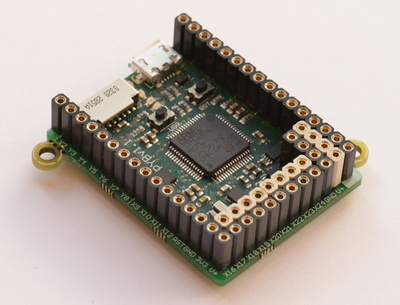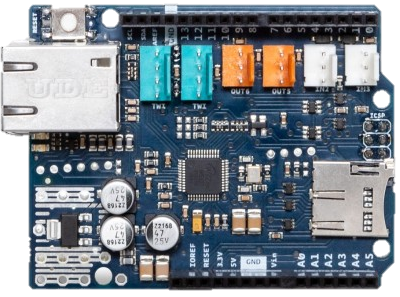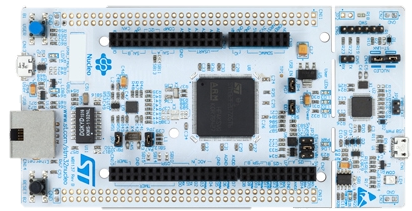DDS on bare-metal embedded hardware devices¶
| authors: | Furkan Ali Yurdakul |
|---|---|
| date: | Feb 2020 |
Possible solutions¶
Research was done concerning different solutions for using the DDS communication protocol in an embedded environment. Each result will be compared to the requirements listed underneath, these were discussed with the project owner.
Requirements:
- It must be easily accessible for an average user. For example: a known website, in stock and doesn’t take more than a week to get it home.
- This solution will have to make use of the TCP/IP communication since this is the base of the DDS communication protocol.
- The hardware must be relatively cheap (max €50). For example: affordable for the average student.
To be able to do this, each solution will have a small summary to create an insight about it. Afterwards there will be a small hypothesis to see if the solution can be used to finish the project within a reasonable timeframe and fits the requirements. The estimated time to fully implement the solution will be given in days and is estimated by experience, knowledge and the amount of work it will need.
SLIP/PPP¶
Summary of the solution
SLIP and PPP are known for implementing TCP/IP protocol in embedded hardware to communicate over serial ports. These protocols have been used a lot in the past and implementation enabled communication over TCIP/IP in most cases. Because this is just about the communication and not the implementation of the DDS communication protocol, this would mean that research has to be performed about the calls that are used to send or receive within the DDS communication protocol.
PPP is a newer version of SLIP but also more complex to use. The complexity will need a lot more storage on your embedded hardware compared to SLIP. PPP also has more configurable options like authentication, compression and encryption. However, in this project all that’s needed is a TCP/IP connection, so SLIP will be preferable in this case.
Hypothesis
This solution would be great to implement since it would make it possible to use DDS communication protocol in a wide variety of embedded hardware. These protocols are made to be used by everyone and the specifications are easy to find. Since it’s a protocol which exists over a longer period, people can find many implementations for known embedded hardware like Arduino. These protocols on their own don’t have any costs, only the hardware will be calculated in the cost. The estimated amount of days it will cost to finish this project using this solution is 60 days.
MicroPython/Pyboard¶
Summary of the solution

MicroPython is an efficient implementation of the programming language Python 3 with the standard libraries and is optimized to run on embedded hardware, specifically for the Pyboard. It also contains hardware-specific modules to make use of different low-level hardware, for example: I2C and GPIO.
The Pyboard is a compact electronic circuit board that runs MicroPython on the bare metal, giving you a low-level Python operating system that can be used to control all kinds of electronic projects.
Hypothesis
Its already known that DDS can be implemented with different kind of programming languages including Python. In this case the Pyboard only misses a connection made by the TCP/IP protocol. The Pyboard is available in online stores and has a lot of resources to fully understand how it works. The Pyboard itself costs €59 which makes it slightly more expensive than the cost requirements. The original Pyboard can be used with SLIP/PPP or the Pyboard “ESP8266 Micropython” can be used. The estimated amount of days it will cost to finish this project using this solution is 70 days.
Arduino + Ethernet¶
Summary of the solution


Arduino has many products in-house. For this project, only the most relevant will be considered. First, there is the standard Arduino UNO Rev3. It is very likely that a programmer has this kind of board and therefore familiar with the programming language C/C++. The disadvantage of this board is that there is no Ethernet port. It can use the SLIP protocol as mentioned earlier, or an Arduino Ethernet Shield 2 can be used. This is an add-on for the standard Arduino, with which you can use an Ethernet port for communication.
Honorable mentions; Arduino Ethernet w/o PoE and Arduino Yun Rev 2. Arduino Ethernet is a retired product and Arduino Yun is a Linux based product. Therefore, these are not suitable for this project.
Hypothesis
On the forums of Arduino, it shows that SLIP has been implemented on Arduino. This makes it possible to use the standard Arduino without the ethernet shield. However, when using the ethernet shield time can be saved to investigate SLIP and its limitations. The Arduino Uno Rev3 costs 20 euro and the Ethernet Shield costs 25 euro, so it will cost 45 euros in total. The expected time for achieving the project with this solution is 60 days.
Embedded RTPS - STM32¶

Summary of the solution
This is the only solution for which there is evidence that the DDS communication protocol has worked. This solution uses the microcontroller: STM32Nucleo-F767ZI. This Microcontroller has an Ethernet port at its disposal so there is no need for SLIP/PPP. According to the GitHub page, this microcontroller has the minimum to create a communication with a Linux device. According to this page, the 2 devices can send at least 10 messages back and forth.
Hypothesis
Because this is a ready-made software package, it must first be investigated whether licenses are required for its use within this project. This concept solution will speed up the time to a result and more time can be spent on a well-made guide. The cost of this controller is 25 euros. It is expected that this can be achieved in 45 days.
Conclusion¶
When looking at the requirements, one is less noticeable but affects a project that is time-limited.
For hardware solutions that can’t directly use TCIP/IP communication, SLIP or PPP can be used. Because implementing SLIP or PPP will take too much time, according to the hypothesis, a separate Arduino or standard PyBoard can’t be used. The Arduino + the Ethernet add on would we applicable, but is too expensive.
We also need to look at how realistic these solutions are. The sources indicate that the “Embedded RTPS - STM32” solution should be able to use DDS, which can be seen from the sources. After a short discussion, it was decided to use the Nucleo for the final result.
Check “Nucleo Setup” to learn how to set up the environment for this device.